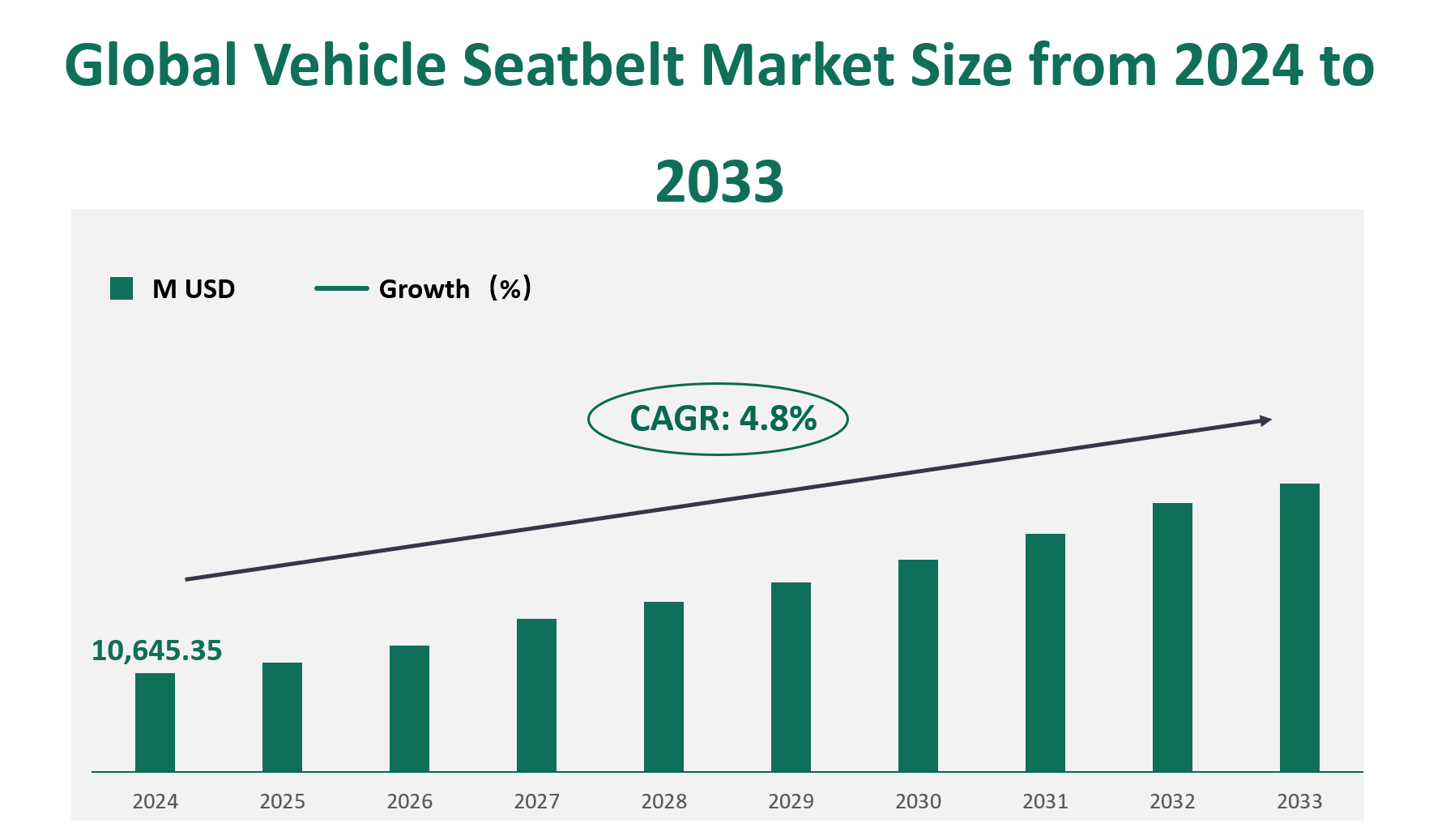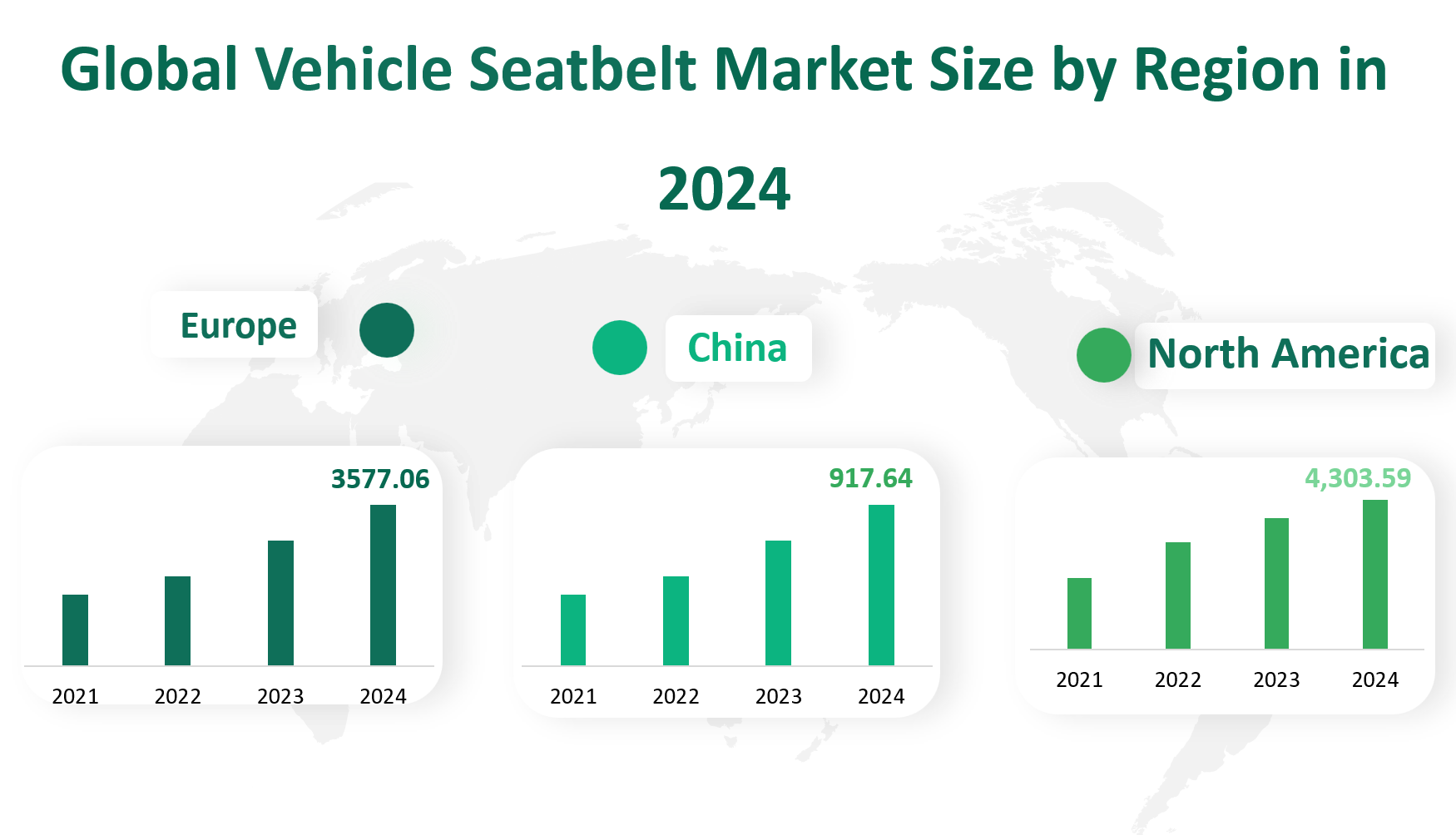1. Global Vehicle Seatbelt Market Insight Analysis
The global vehicle seatbelt market is projected to reach a value of $10,645.35 million USD in 2024, with a Compound Annual Growth Rate (CAGR) of 4.80% from 2024 to 2033.
A vehicle seatbelt is a crucial component of automotive safety systems, designed to secure occupants during collisions and reduce the risk of injury or death. Seatbelts work by counteracting the deceleration forces experienced during a crash, preventing occupants from colliding with interior components of the vehicle such as the dashboard, steering wheel, and windshield.
Modern seatbelts are engineered with advanced materials and technologies to provide optimal comfort and safety. They include features such as pre-tensioners, load limiters, and adjustable restraints to ensure that occupants are securely held in place during both normal driving conditions and in the event of an accident. The integration of seatbelts with other safety systems, such as airbags, further enhances their effectiveness in protecting vehicle occupants.
Figure Global Vehicle Seatbelt Market Size (M USD) and CAGR (2024-2033)

2. Driving and Limiting Factors of Vehicle Seatbelt Market Growth
The growth of the vehicle seatbelt market is influenced by several key factors. The primary drivers include increasing awareness of road safety, stringent government regulations mandating seatbelt usage, and the rising demand for advanced safety features in vehicles. The high incidence of road traffic accidents globally has led to a greater emphasis on vehicle safety, driving the demand for seatbelts. Additionally, the growth of the automotive industry, particularly in emerging markets such as China and India, has contributed to the expansion of the seatbelt market. As car ownership rates continue to rise, the need for seatbelts as a standard safety feature also increases.
However, there are several limiting factors that may hinder the growth of the vehicle seatbelt market. One significant challenge is the high initial investment required for the production of seatbelts, which can deter new entrants from entering the market. Additionally, fluctuations in raw material prices, such as those for nylon and polyester, can impact the profitability of manufacturers. Labor costs are also a concern, as the production of seatbelts is labor-intensive, and rising wages in various regions can increase manufacturing costs. Furthermore, the market faces intense competition from established players, making it difficult for new companies to gain a foothold.
3. Technology Innovation and Corporate Mergers and Acquisitions in Vehicle Seatbelt Market
The vehicle seatbelt market is characterized by continuous technological innovation and strategic corporate activities. Companies are investing heavily in research and development to enhance the safety and functionality of seatbelts. For instance, active seatbelts that use advanced sensors and algorithms to detect potential collisions and tighten the restraints before impact are becoming more prevalent. These innovations not only improve safety but also provide a competitive edge for manufacturers.
Corporate mergers and acquisitions have also played a significant role in shaping the market. Major players such as Autoliv and Joyson Safety Systems have engaged in strategic acquisitions to expand their product portfolios and strengthen their market positions. For example, Autoliv’s acquisition of LiDAR and Time of Flight camera expertise highlights the company’s commitment to integrating advanced technologies into its safety systems. Similarly, Joyson Safety Systems’ acquisition of Takata Corporation’s assets has significantly enhanced its capabilities in the global market.
4. Global Vehicle Seatbelt Market Size by Type
Passive Seatbelts are the traditional type that requires manual intervention from the occupant to fasten and unfasten. They are designed to lock during a collision, preventing the occupant from being ejected or moving excessively within the vehicle. Passive seatbelts are widely used in both commercial vehicles and passenger cars due to their simplicity and reliability.
Active seatbelts incorporate advanced technology to enhance safety. They use active information security systems, such as radar, cameras, or electronic stability control (ESC) systems, to react before a collision occurs. These seatbelts can pre-tension or adjust automatically to provide optimal protection. Active seatbelts are often found in high-end vehicles and are becoming more prevalent as technology advances.
With a market value of 5068.77 million USD in 2024, passive seatbelts continue to hold a substantial share of the market.
Active seatbelts, with a market value of 5576.58 million USD in 2024, are gaining significant traction
Table Global Vehicle Seatbelt Market Size by Type in 2024
5. Global Vehicle Seatbelt Market Size by Application
Commercial Vehicles include multi-purpose vehicles designed for commercial activities, such as vans, trucks, and buses. Seatbelts in commercial vehicles are essential for ensuring the safety of drivers and passengers during long journeys and heavy-duty operations. With a market value of 3038.84 million USD in 2024, commercial vehicles represent a significant portion of the seatbelt market.
Passenger cars are designed primarily for transporting passengers and their luggage. Seatbelts in these vehicles are crucial for protecting occupants in the event of an accident. The demand for seatbelts in passenger cars is driven by increasing car ownership and stricter safety regulations. Passenger cars are the largest application segment for vehicle seatbelts, with a market value of 8359.81 million USD in 2024.
Table Global Vehicle Seatbelt Market Size by Application in 2024
Application | Market Size (M USD) 2024 |
Commercial Vehicle | 3038.84 |
Passenger Car | 8359.81 |
Others | 762.42 |
6. Global Vehicle Seatbelt Market by Top Regions
North America remains the largest regional market by revenue, with an estimated value of 4,303.59 million USD in 2024. The region’s dominance is attributed to its mature automotive industry, high consumer awareness of safety, and stringent regulatory requirements.
Europe follows closely with a market value of 3,577.06 million USD in 2024. The region’s automotive industry, especially in countries like Germany, France, and the United Kingdom, contributes significantly to the global seatbelt market.
China is the fastest-growing market for vehicle seatbelts, with a projected value of 917.64 million USD in 2024.
Japan’s market value is estimated at 737.62 million USD in 2024. The country’s automotive industry, known for its high-quality standards and technological advancements, continues to drive the market.
The Middle East and Africa market is projected to reach 149.35 million USD in 2024.
India’s market value is estimated at 377.59 million USD in 2024. The country’s rapid economic growth and increasing car production have driven the market.
South America’s market value is projected at 142.14 million USD in 2024. The market benefits from increasing economic stability and a growing demand for automotive safety products.
Figure Global Vehicle Seatbelt Market Size by Region in 2024

7. Global Vehicle Seatbelt Market Analysis by Major Players
7.1 Autoliv
Company Introduction and Business Overview: Autoliv is a global leader in automotive safety systems, with a strong presence in Europe and North America. The company was established in 1997 and has over 67,000 employees across 27 countries. Autoliv focuses on developing advanced safety technologies for vehicles, including seatbelts, airbags, and electronic safety systems.
Products Offered: Autoliv offers a wide range of seatbelt systems, including passive and active seatbelts. Their products are designed to meet the highest safety standards and are used by major car manufacturers worldwide.
7.2 Joyson Safety Systems
Company Introduction and Business Overview: Joyson Safety Systems, established in 1986, is a leading provider of automotive safety systems. The company operates in North America, Asia-Pacific, and Europe, offering a comprehensive range of safety products, including seatbelts, airbags, and steering wheels.
Products Offered: Joyson Safety Systems provides both passive and active seatbelts, with a focus on innovation and high-quality standards. Their products are designed to enhance vehicle safety and meet global regulatory requirements.
7.3 TRW Automotive
Company Introduction and Business Overview: TRW Automotive, established in 2002, is a major supplier of automotive products, including seatbelts. The company operates globally, with a strong presence in North America and Europe. TRW Automotive is known for its advanced safety technologies and high-quality products.
Products Offered: TRW Automotive offers a range of seatbelt products, including next-generation seatbelt buckles and pretensioners. Their products are designed to provide enhanced safety and comfort for vehicle occupants.
7.4 Beam’s Seatbelts
Company Introduction and Business Overview: Beam’s Seatbelts, established in 1953, is one of the oldest manufacturers of seatbelts. The company is known for its high-quality restraint systems and innovative products. Beam’s Seatbelts operates primarily in North America and has a global sales network.
Products Offered: Beam’s Seatbelts offers a variety of seatbelt systems, including the Tri-Lock™ seatbelt system, which provides off-road harness control and daily drive comfort. Their products are designed to meet the needs of both on-road and off-road enthusiasts.
7.5 Tokai Rika Co.Ltd
Company Introduction and Business Overview: Tokai Rika Co.Ltd, established in 1948, is a leading manufacturer of automotive electronic parts, including seatbelts. The company operates in Asia-Pacific, Europe, and North America, with production facilities in Thailand, the UK, and the US. Tokai Rika is known for its innovative safety technologies and high-quality products.
Products Offered: Tokai Rika Co.Ltd offers a range of seatbelt products, including retractors with pre-tensioner systems and force limiters. Their products are designed to enhance vehicle safety and meet global regulatory standards.

